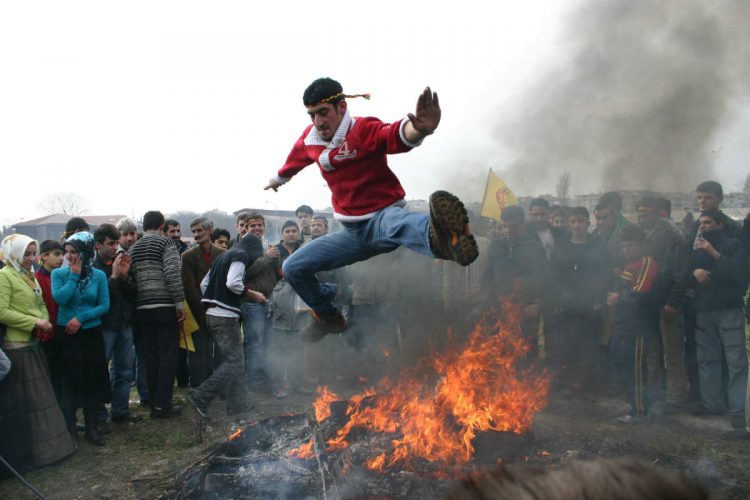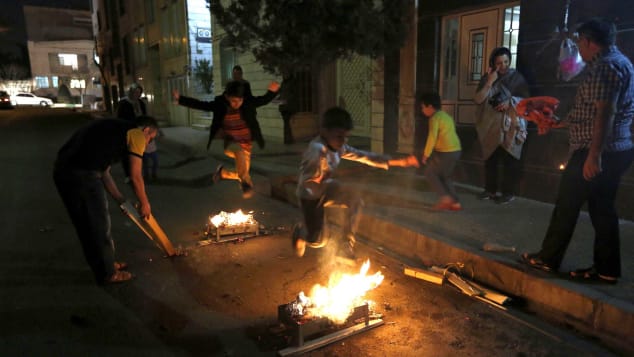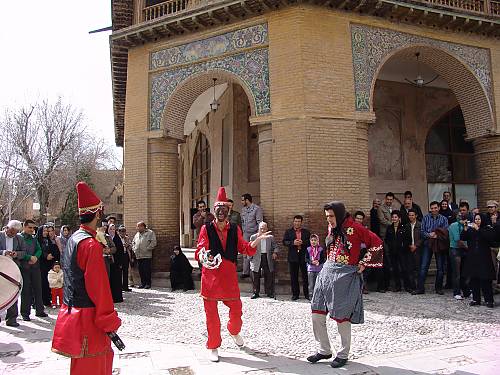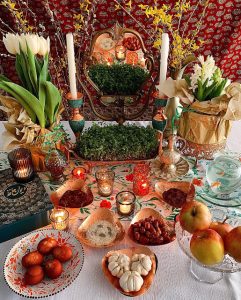How do Iranians celebrate Nowruz
februaray 2022
Nowruz celebrates the awakening and rebirth of nature after winter
Nowruz is a festive period that lasts for thirteen days and is the happiest holiday of the year. Every year Nowruz begins at a different time, for practical purposes the new year begins at midnight closest to the instant of the vernal equinox, in this year 2022 (Farvardin 1, 1401) at 19:03:26 (Tehran time). ) of March 20th according to the Gregorian calendar (16:33:26 Madrid time), [see the article A brief reflection on the Iranian calendar, by Dr. Heydari Malalayeri, on this same website https://iranologia.es/ 2020/06/22/about-the-persian-calendar/ ] Every Iranian knows the exact time of the arrival of spring to meet with his family and celebrate it.
Preparations begin a few weeks before the date when the spirit of renewal is revived, so sales of clothing and household items increase considerably. The celebration has a strong influence of Zoroastrianism, with the fight of good against evil; the arrival of the new year represents the end of the winter darkness and the rebirth of light and fertility. Among the popular acts with which this festival is prepared and welcomed in Iran is the so-called Hāji Firuz (حاجی فیروز) . It is said that Hāji Firouz was a man dressed in red and with a face covered in soot, as he is inspired by the Zoroastrian figure of the “guardian of fire” who went from street to street singing and playing the tambourine to greet the new year and inform to the population of the arrival of spring; to compensate him for having brought the good news, people gave him food or some coins. Thus, in the days preceding Nowruz, the Hāji Firouz of today still descend the streets of Iranian cities and towns dressed in colorful clothes and with a pointed hat, their faces black with coal, they shake the daf (the tambourine rattle ), sing old auspicious verses and respond to small cash gifts by wishing the best for the new year. So every year Iranians celebrate the rebirth of nature and new life.



The festive period begins on the eve of the last Wednesday of the Persian calendar year known as “Feast Wednesday”, Čahāršambe suri (چهارشنبه سوری) or “red Wednesday”, in which people light small bonfires in the streets, courts, etc. at sunset and jump over them, reciting “Zardi ye man az to, sorji ye to az man” “For you my yellow, for me your red” (yellow symbolizes disease and red, referring to fire, represents the color of health, fire removes all diseases, problems, paleness and instead gives us energy, life, warmth and health). Rockets and firecrackers are launched and then, when the bonfires are consumed, the ashes are collected and buried, warding off the bad luck of the winter season. This ritual is related to the divine symbology of fire by Zoroastrianism. Children take to the streets banging pots and pans (qāšoq zani) asking for a bonus. Fālguš (omen) are announced and heard.
After this ceremony, families gather at their elders’ houses and share the special meals of this night such as āš-e rešte (آش رشته), āš is a type of thick soup prepared with rešte (thin noodles), kašk ( a fermented milk product similar to a sour yoghurt) (in short a stew of vegetables and legumes), ‘ayil-e moškel gošā (عجیل مشکل گشا) is a mixture of nuts and sweet fruits such as pistachios, almonds, chickpeas, hazelnuts, walnuts, cashews, raisins and dried apricots.
On the last day known as Sizdah bedar (سیزده بدر), which could be translated as “thirteen in the air” or “thirteen in the countryside and nature”, families go to the countryside to have picnics and enjoy nature; it is considered bad luck to stay indoors on this day, and here one of the elements of the Haft Sin, is taken up again, as the young shoots of the Sabzeh are scattered with the purpose of contributing to nature and getting rid of the bad luck absorbed in the home.
On the last Thursday of the year, people usually go to the cemetery to visit and pray for their loved ones. They wash the graves with rose water (golāb), put flowers on the graves, recite some verses from the Koran and pray. They then offer people dates, drinks, fruits, sweets, halvā (a traditional sweet made of flour, saffron, sugar, oil, rose water), etc. in memory of their deceased.
SOFRE-YE HAFT SIN (The tablecloth of the seven “S”)
From weeks before the party the Iranians begin to prepare it. The first thing they do is thoroughly clean the whole house jāne tekāni ““deep cleaning of the house” (literally “shake the house”), they wash the carpets, paint the walls, throw away the old things and make everything bright for nowruz. , etc. Then they start shopping: They buy new clothes especially for the children, sweets, nuts, seasonal fruit, etc. and they prepare the Haft Sin, the seven objects or foods that begin with the letter Sin of the Persian alphabet and that they will present on a decorated table on the day of the party. About the Haft Sin ritual, the most traditional thing in the ceremony is to prepare 7 different dishes that have a particular meaning, as indicated below. One of the traditional dishes on this day is rice made from finely chopped fresh herbs with fish (sabzi polow bā māhi).
Next to these seven plates (in Persia, seven has been a sacred number since ancient times) other objects are placed to ensure the arrival of good luck. Golden coins, painted eggs, a goldfish bowl, bouquets of daffodils or hyacinths as a symbol of spring, an orange in a bowl of water, a mirror and a Koran. A candle is usually lit for each child in the family..
The Iranians also prepare their Sofre ye haft sin, that is, the tablecloth of seven objects that begin with the letter “S” in Persian, each object symbolizes something different, which are the following:
- Sib ( سیب ) apple, symbolizing beauty and health.
- Serke (سِرکِه ) vinegar, symbolizing age and patience.
- Sir (سیر ) garlic, symbolizing medicine and health.
- Somāq (سُماق ) sumac berries, symbolizing symbolizes the color of dawn, the sun.
- Samanu ( سَمَنو ) as a mash made from wheat germ and flour, it is customary to be prepared by women, which symbolizes abundance and blessing.
- Senŷed (سِنجد ) dried fruit of azucaifa, which represents love and wisdom.
- Sabze (سَبزه ) germinated seeds of wheat, lentil, etc. symbol of the arrival of spring and the rebirth of life.
Regarding sabze, a few weeks before this holiday, each Iranian family plants seeds of lentils, wheat, or barley, etc. in a container. When they are germinated and well grown they normally put a red ribbon around these sprouted seeds, then they place it as an ornament on their sofre ye haft sin. On the same tablecloth of the seven eses, each family also places its sacred book, for example, the Koran (for Muslims), the Avesta (for the Zoroastrians, the Bible, etc, or some book of poetry, usually by Hāfez or Ferdowsi, the book represents civilization. and other objects:

- Some coins sekke (سِکِه ), symbol of prosperity and wealth.
- Hyacinth sombol (سنبل ) for its beauty, or lilies, tulips, etc.
- A clock sā’at (ساعت ) because of the importance of time and especially the exact time of the new year.
- A mirror āyine (آینه ) symbol of truth, self-reflection, and the real world.
- A fish tank with small red fish mahi symbolizing the course of life;
- ‘ayil, a mixture of salty and sweet nuts such as almonds, chickpeas, pistachios, hazelnuts, cashews, raisins, dried figs, etc.
- Painted eggs: symbol of fecundity/fertility.
- An orange floating in a bowl of water symbolizing the Earth floating in space.
- Some photo of their loved ones who are not with them.
- Candles, Fruit Bread etc.
- Sweets: symbol of the sweetness of life; bāqlavā a fine paste filled with honey, almonds, pistachios, rose water; nān e nojodči small sweets made from roasted chickpea flour.
SĀL E TAHVIL سا ل تحویل
A little before the moment of the equinox and the new year, the whole family sits around the tablecloth of seven esses, waiting for the exact time of the arrival of the sun in the constellation of Aries, which varies each year. The whole family savors these special moments together, praying the special prayer of these moments, reading their holy book or some poetry, etc. After the exact start of the Persian New Year, that is to say sāl e tahvil all family members congratulate each other, wish each other a good new year, kissinin all, and give each other gifts and eat sweets.
As a Nowruz gift, the older ones usually give ‘eidi to the smaller ones, which is usually money, which must be new bank-notes, so a few weeks before they get new bills from the banks, then they put these new notes inside or on top of the Koran so that they are blessed. After sāl e tahvil they take them out to give away.
There are many people who choose to travel, do tourism or make a pilgrimage to different sacred sites, so they organize their New Year’s trip in advance

